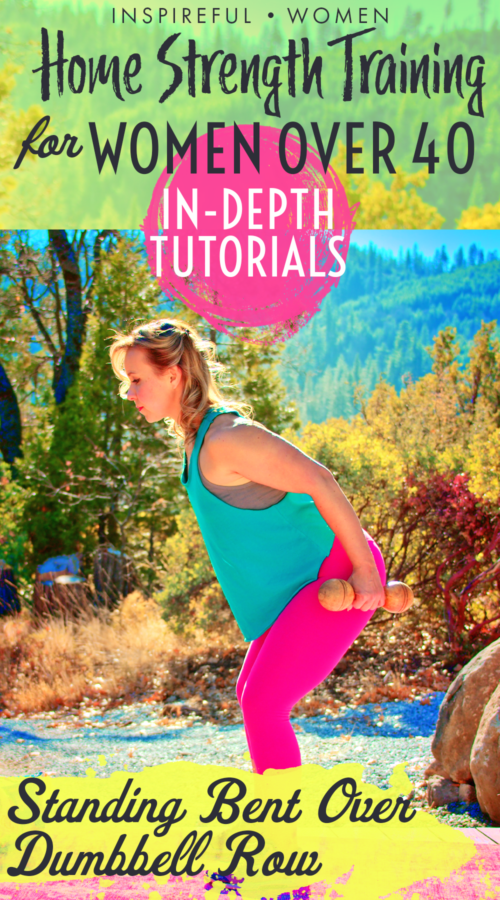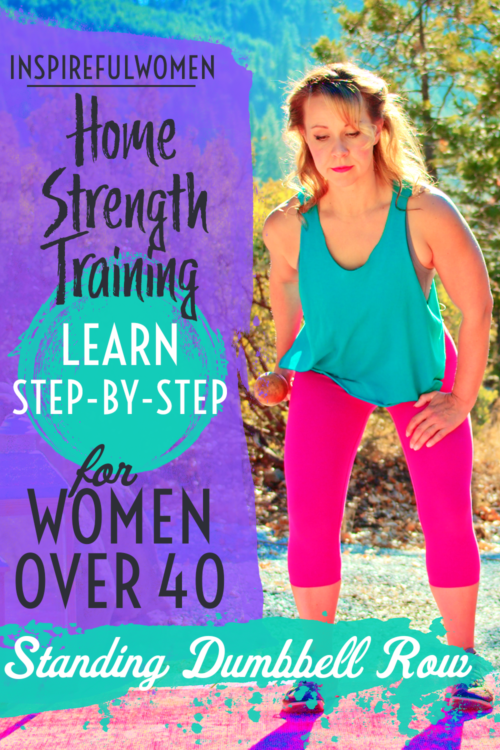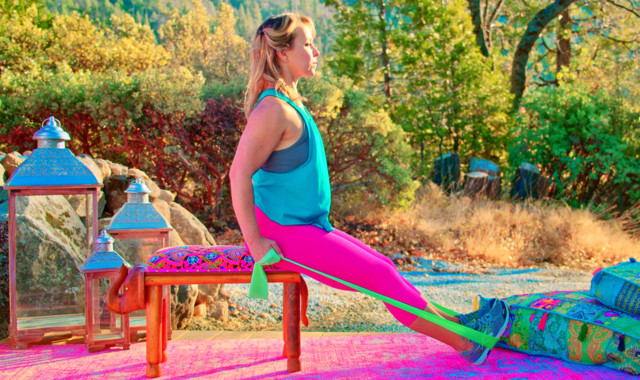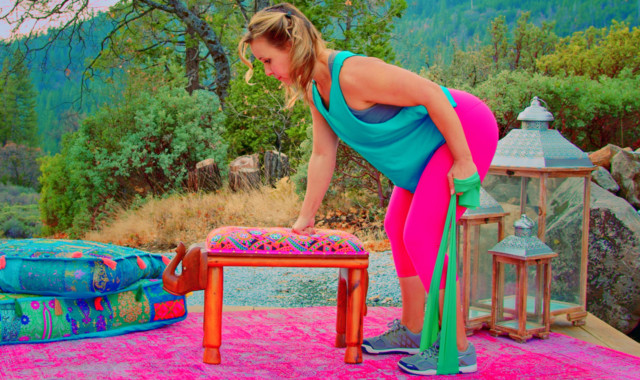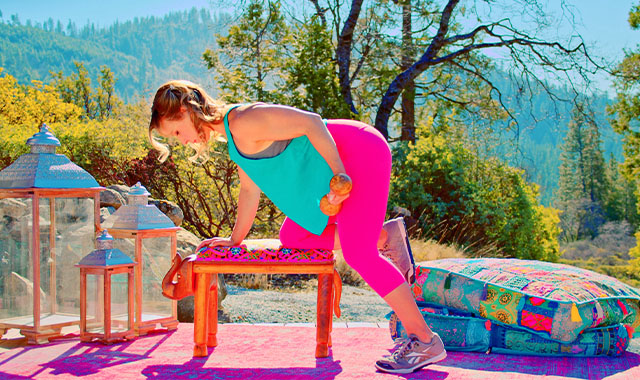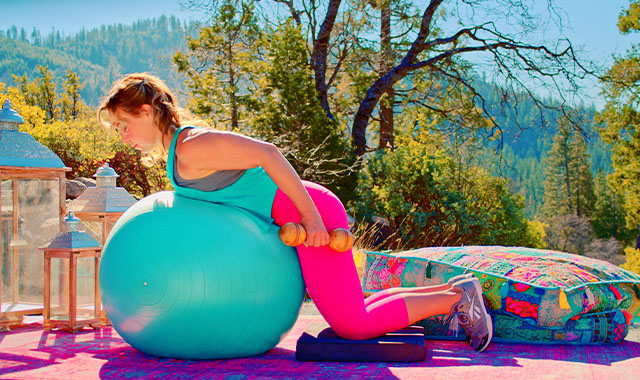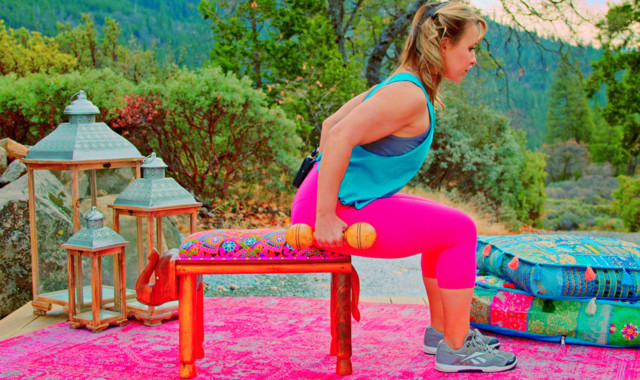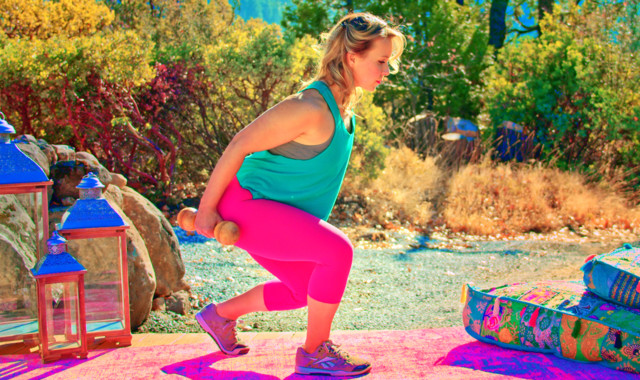Standing Bent Over Dumbbell Row
How to Do the Standing Two-Arm Bent Over Dumbbell Lat Row | In-Depth Guide [VISUAL LEARNERS] Intermediate
Proper Form, Common Mistakes, & Variations | Home Resistance Training
WHAT DO YOU WANT TO SEE?
QUICK DEMO
QUICK DEMO
MUSCLES THIS WORKS
MUSCLES
MAIN MUSCLES WORKED IN Standing Bent Over Dumbbell Rows
LATS
The "lats" as they are affectionately called...lol just kidding - anyway, "lats" is short for Latissimus Dorsi which is the widest muscle of the upper body and the largest muscle of the back .
OTHER MUSCLES WORKED:
- Middle and Lower Traps
- Rhomboids
- Serratus anterior
- Triceps
- Teres major
- Rear deltoid
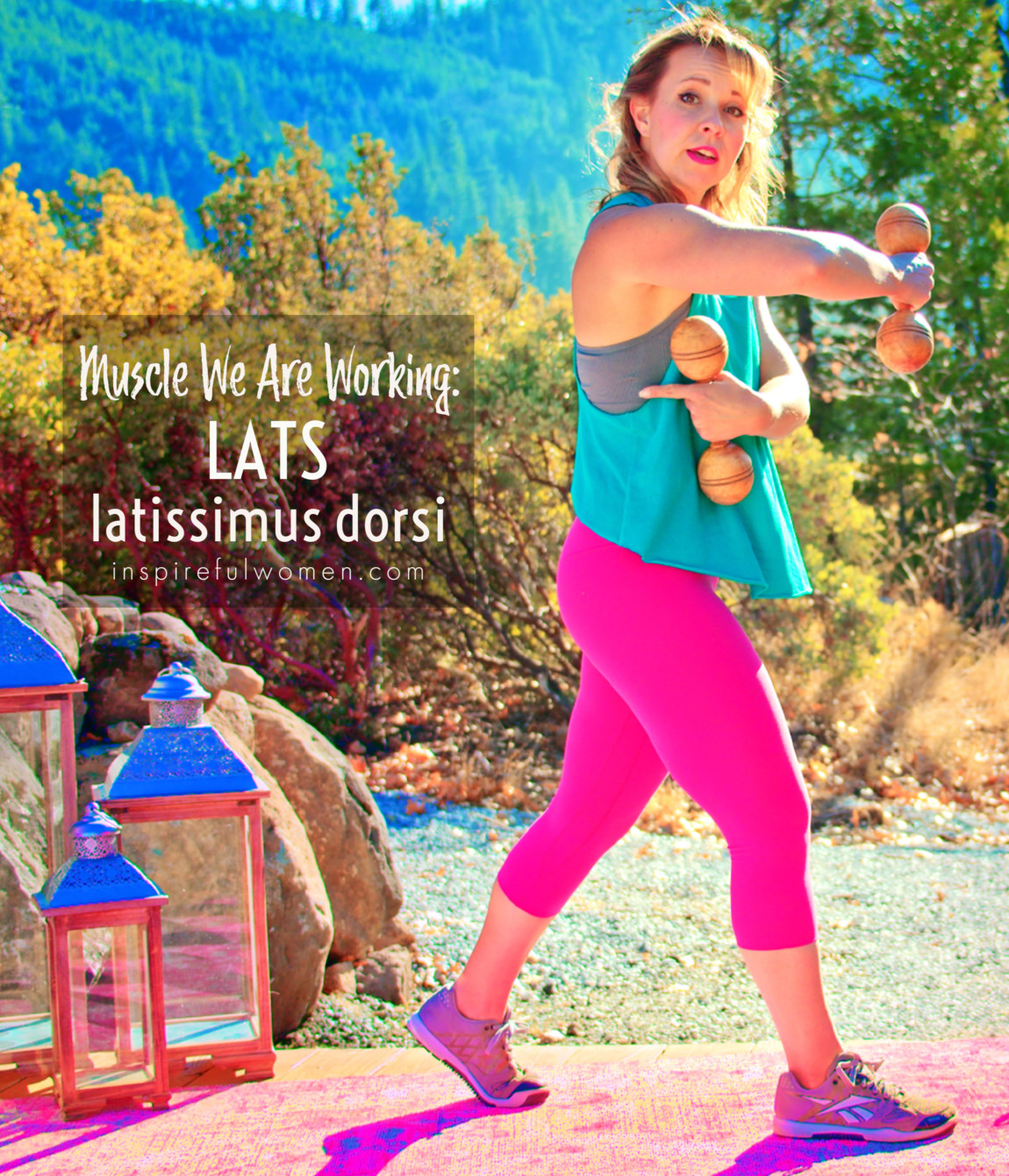
STARTING POINTERS
Starting Pointers
WHAT WE'RE DOING TODAY
ALL WE'RE DOING:
In a bent-over position, we're going to pull those dumbbells to our hips.
This is the standard version of a bent-over row, using dumbbells and working both arms at the same time. The standing bent-over dumbbell row is a highly effective exercise for building upper body strength, improving posture, and enhancing core stability.
Personally, I feel like working both arms at once for this particular muscle group, the lats, is very challenging to pay attention to keeping proper form while also truly fatiguing the lat muscles well. More often than not, I like to do single-arm versions, but depending on the timing of your workout, it's always good to have double-arm options.
This exercise is done in standing which makes it a good exercise for strengthening the stabilizing muscles of the torso and legs. Strengthening the torso and legs while working the arms is extremely functional - it is how we use our bodies all day long. Training the arms without strengthening the muscles of the torso and legs can result in muscle imbalances - the arm muscles are really strong but the core is weak. This can set you up for an of the spine, shoulders, and hips.
The forward lean position of this exercise works the muscles of the back extensors while using the arms. The use of dumbbells allows you to work the arms independently to identify and correct differences between your left and right sides.
HOW TO FEEL WHAT MUSCLE IS WORKING
How to Feel What Muscle is Working
Option 1: While standing, take one hand across, and touch near the bra line, just under the armpit. Actively press your shoulders down and elongate the torso/spine up, feel that muscle moving/contracting. That is part of your lat muscle.
If you don’t feel anything you can try it this way:
Option 2: While seated, take one arm across - but just below their breasts, and feel the lat just under the armpit. Take your arm on the side you are activating and push the hand down into the seat of the chair. Like a seated press-up. If your shoulder blade is elevated or in slight protraction you will not be able to get a good lat contraction, so be sure to pull your shoulder blade back and down, THEN push down and in with your upper arm. You will feel a strong lat activation just below your armpit along the side of your body.
HOW TO DO THE EXERCISE
LOOKS
HOW Standing Bent Over Dumbbell Rows SHAPE OUR BODY
Building the lat muscles contributes to what they call a “V-taper” - it adds to a more hourglass-ish, slim waist appearance.
Confident and healthy upright posture.
PROPER FORM
PROPER FORM: Standing Bent Over Dumbbell Row
EQUIPMENT, SETS & REPS
EQUIPMENT
SUGGESTED STARTING WEIGHT FOR WOMEN:
8-10 lbs
SETS & REPS:
2 sets of 8 - must fatigue the muscles.
PACE:
Moderate up - with control and back stability, and lower down for the eccentric component.
BODY POSITION
BODY POSITION FOR THE Standing Bent Over Dumbbell Row
HAND/GRIP: Neutral, so palms will face each other, this should be a comfortable grip.
FEET: Hip width apart, toes forward.
BODY STANCE: Knees slightly bent to provide a stable base. Trunk leaning forward 50-70 degrees - dependent on low back strength and hamstring length, must be able to keep the spine in a neutral position and stable. It is ok to lean over further (up to 90 degrees) but your back must be neutral and sternum lifted, chest broad. Increasing the lean increases the muscle activity in the back - further than 90 degrees (parallel to the floor) will decrease the muscle activity.
ARM: When bent over, dumbbells are held about 1-2 inches from outside of the knee. Your elbows should be relaxed/soft. The exact location of the dumbbell will be dependent on how far you are leaning over and the length of your arms/legs - they may be at knee level or lower.
HOW TO DO
HOW TO DO Standing Bent Over Dumbbell Rows
CUE: Focus on pulling your elbows back and in- like your elbows are headed for your back pockets.
Move your shoulder blades in and down your spine.
Pull the upper arm back (towards ceiling/back wall). Let your elbow bend as the upper arm moves back. Try to resist the urge to use your biceps at this point.
Pull the upper arm back behind the body, inwards towards the midline (the spine), and down towards your low back.
Your elbows will be behind your back at the end of the movement. Pause and squeeze the lat muscles.
Return to the starting position with slow control and repeat.
HOW TO SAFELY GET OUT OF THE EXERCISE
Stand up, squat down to set the weights on the floor.
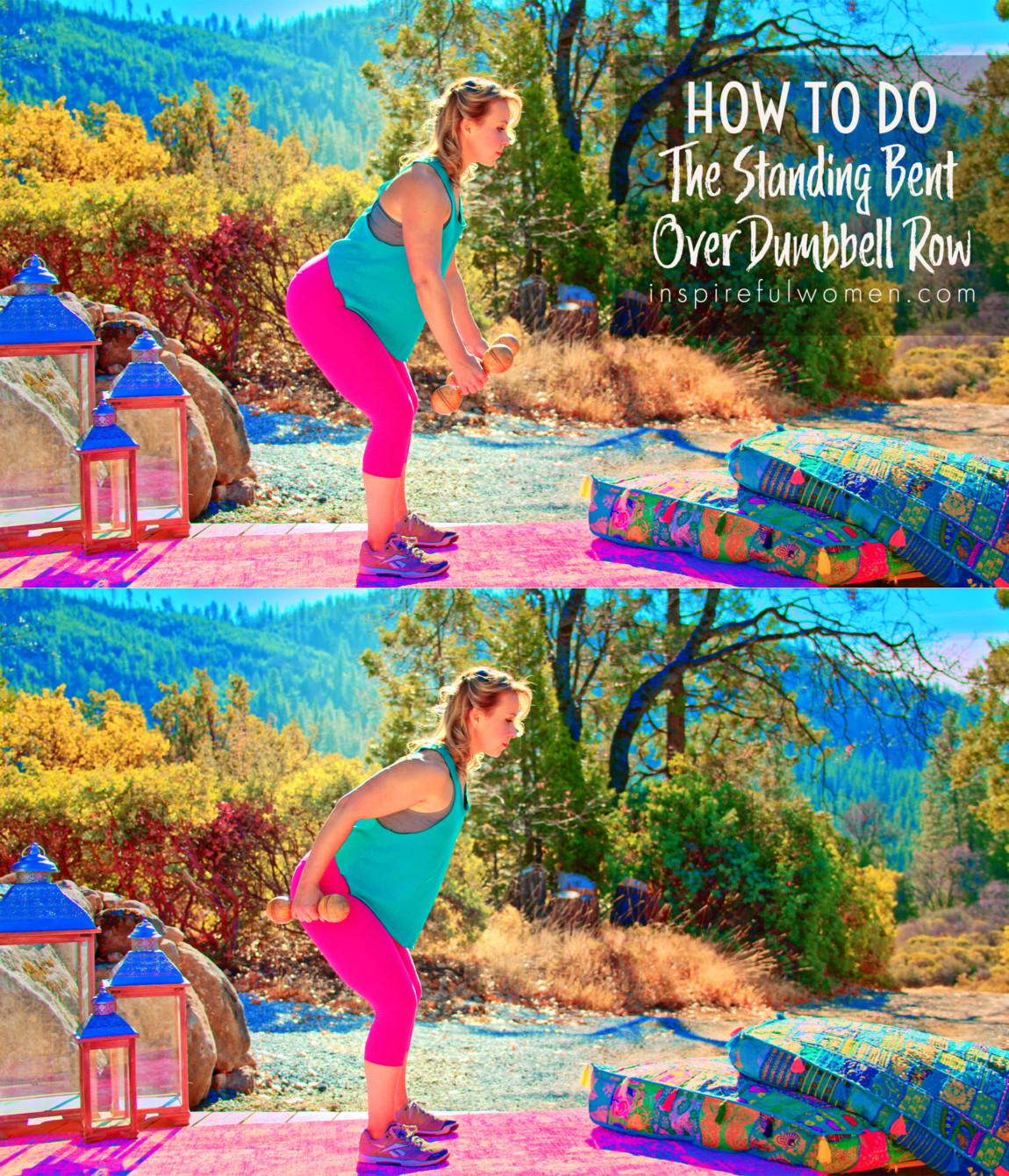
COMMON MISTAKES
COMMON MISTAKES
WHAT TO AVOID WITH THE Standing Bent Over Dumbbell Row
KEY TIP:
Guess what? Good news! Many avoids are the same for most movements. Once you learn the basics, there's really only a few extra avoids for each individual movement.
1. Avoid Straightening Or Locking The Knees
AVOID: Avoid straightening or locking the knees
WHY NOT?
- This tends to decrease the lumbar curve, pull on the hamstrings and decrease the muscle activity of the legs.
WHAT TO DO:
- The knees should be soft, locking the knees puts stress on the knee joint and can make it more difficult to maintain a neutral spine [n/a seated].
- If you feel pressure or discomfort in the low back or knees - try bending the knees.
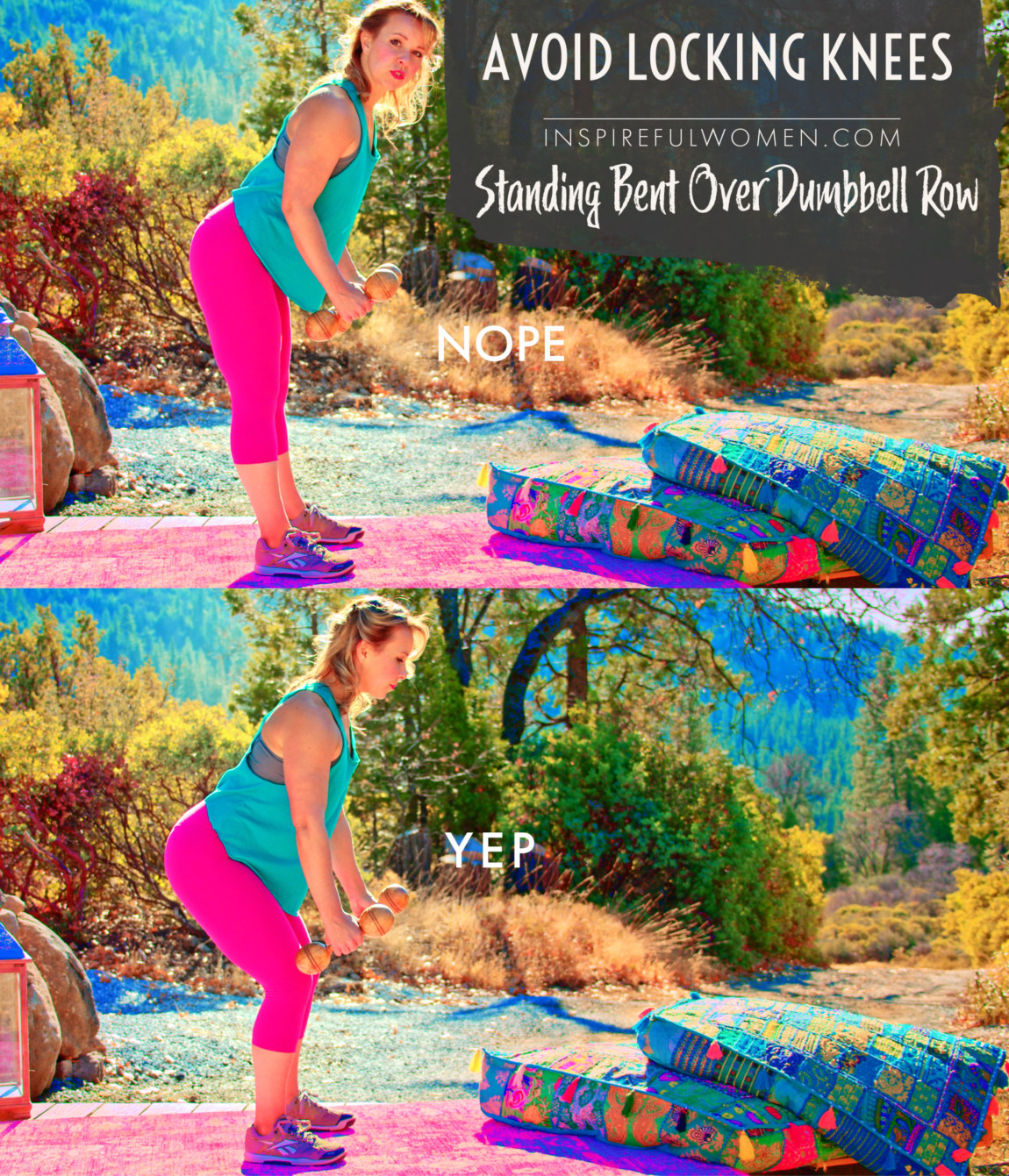
2. Avoid rounding/Arching your back
AVOID: Avoid arching(extending) or rounding (flexing) your low back
WHY NOT?
- Can lead to muscle strain or low back joint injury, it will also decrease the activation of the targeted muscles. Maintain a neutral spine position.
- Pressure or discomfort in your low back.
WHAT TO DO:
- Maintain a neutral spine position to prevent low back joint injury, muscle strain, or damage over time.
- Troubleshooting suggested fixes:
- Poor core strength: activate your abdominal muscles, or do choose a position with more support.
- Poor back extensor strength: choose a position with more support.

3. Avoid using neck muscles
AVOID: Avoid using your neck
WHY NOT?
- The neck should be neutral and relaxed, space between the earlobe and top of shoulder - this can lead to neck and/or shoulder injury over time and it prevents you from using the correct muscles. This can lead to neck strain, injury, or damage over time.
- You may feel neck discomfort, find that you are pressing down with your head, or gripping with your neck muscles.
WHAT TO DO:
- Gripping neck muscles in an attempt to stabilize the shoulders: relax the neck and activate the core muscles more, activate the scapular stabilizers in retraction and depression.
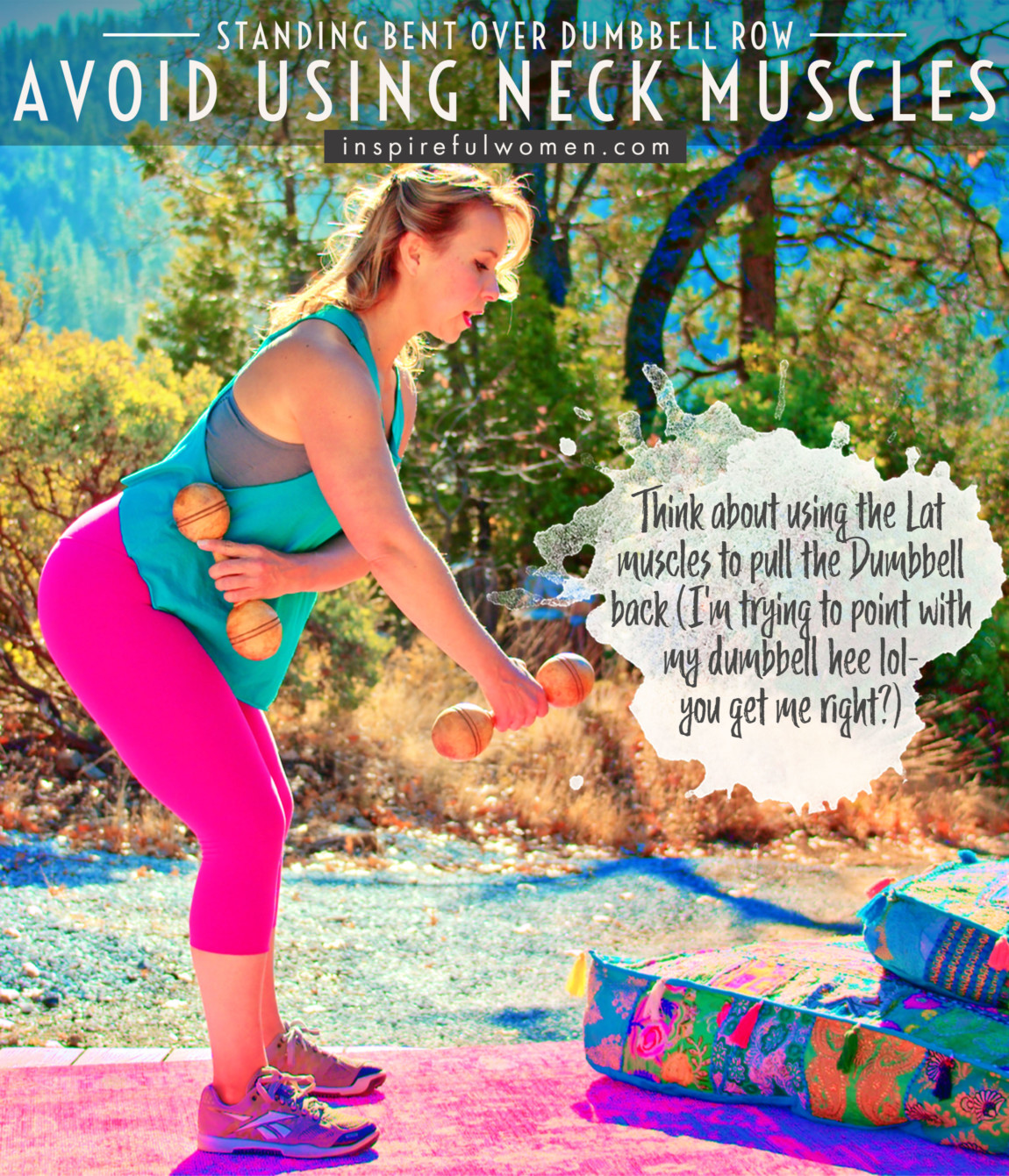
4. avoid rotating torso/hips
AVOID: Avoid rotating torso
WHAT TO DO:
- The hips and shoulders should be squared throughout the exercise. This will strengthen the muscles in the healthiest way and it will limit stresses on the joints and muscles of the spine, shoulders and hips.
- Troubleshooting and suggested fixes
- Poor set up: check foot position, hand position, height of bench (if applicable), height of anchor (if applicable).
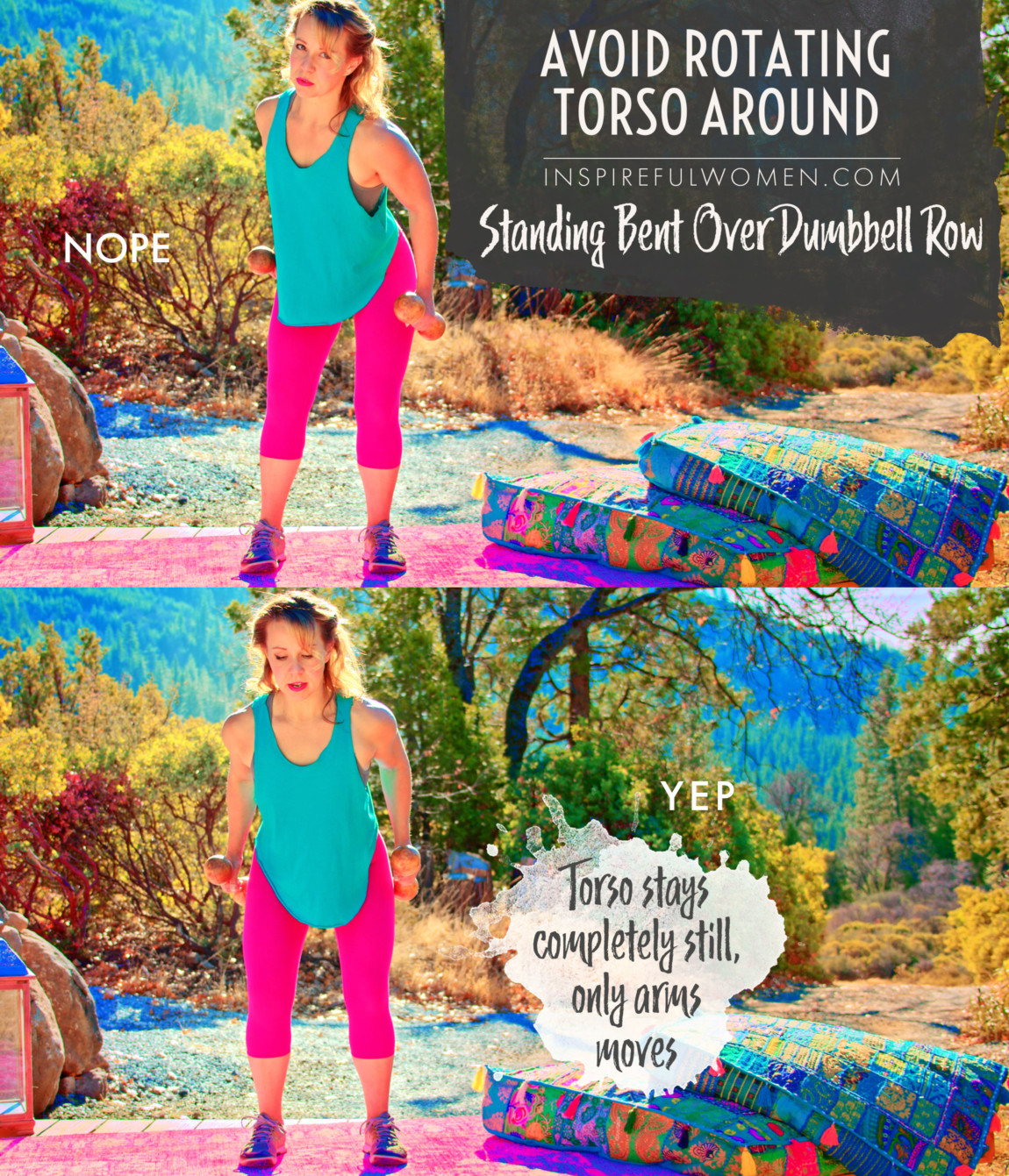
5. Avoid elbow flaring out
AVOID: Avoid letting the elbows flare outwards from your body as you move them upwards.
WHY NOT?
- This will cause the back of your shoulder muscle (rear deltoid) to do more of the work and the latissimus dorsi to do less of the work.
WHAT TO DO:
- Pull elbow in close to body.
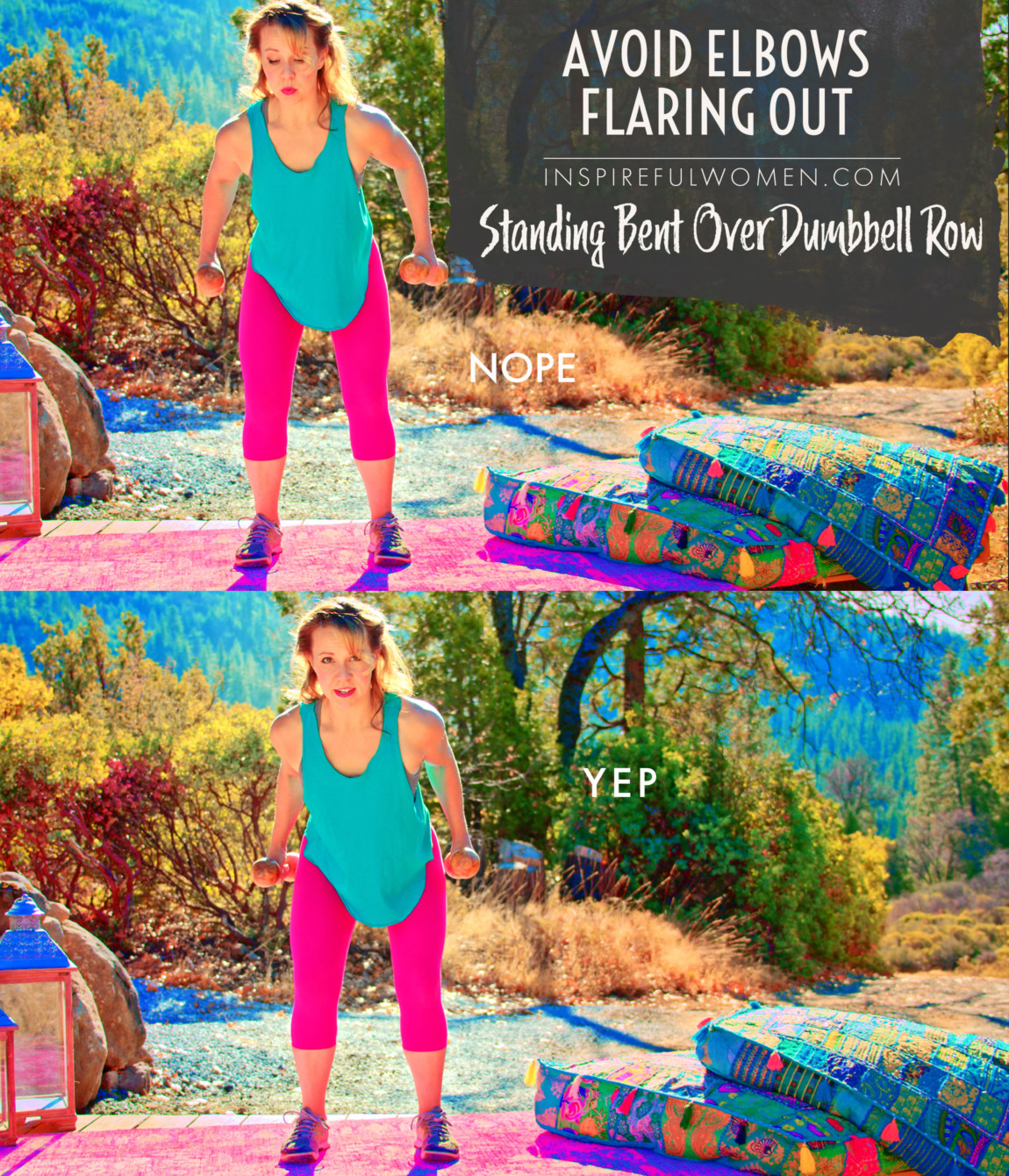
6. Avoid making it a bicep curl
AVOID: Using the biceps to lift the weights
WHY NOT?
- The goal of the exercise is to use the lats.
- This may happen if you find yourself doing mostly bending at the elbow rather than moving through the extension of the shoulder behind you.
WHAT TO DO:
- Correct form and focus: the elbow does bend but it is a passive movement as the upper arm is lifted back. Avoid actively (using the biceps) bending the elbow.

VARIATIONS
VARIATIONS
VARIATIONS OF Standing Bent Over Dumbbell Rows
Single Arm Standing Row
Single Arm Standing Row
This allows you to focus on one arm at a time. The arm that is not working (not completing the row) can be held down and relaxed or it can be held back at the top of the row to keep tension on the muscles as the other arm works. Working one arm at a time will work the muscles of the core a bit differently - the quadratus lumborum (to prevent side bending) and obliques (to prevent rotation) will be more active.
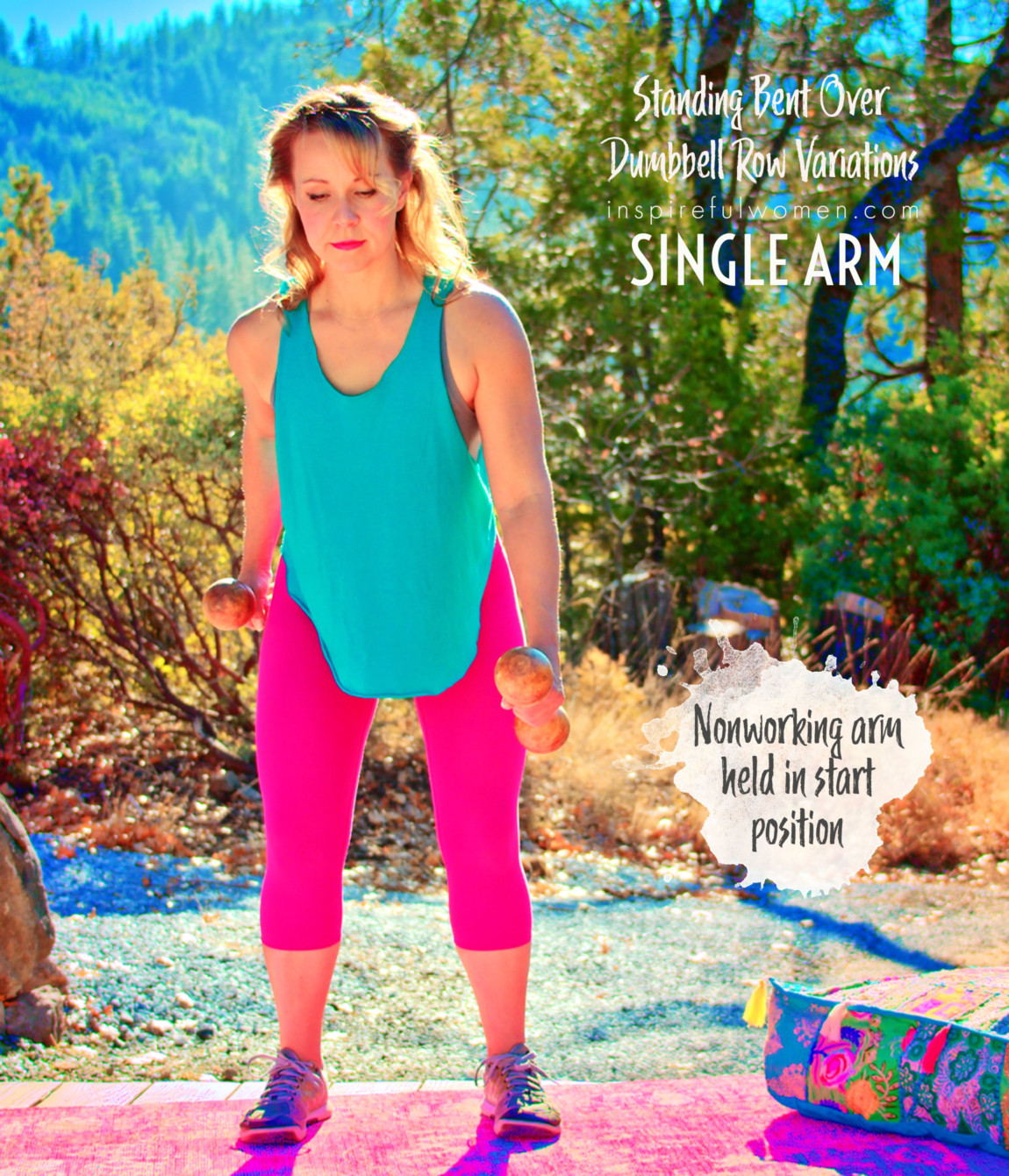
WHAT WE'RE DOING TODAY
WHAT & WHY
BENEFITS OF TRAINING THE lats
WHAT
Other names for this exercise: Standing Dumbbell Row, Dumbbell Row Standing
WORKIN' OUR BACKSIDE
Sometimes we think of our backside as just the bottom half of us don't we! But today, we're working our OTHER backside- the top half.
The bent over row will work the latissimus dorsi muscle - which translates to “widest back”, it is most commonly called the lat muscle. The lat is shaped a little bit like a wing, and it can pull the arms in close to the body. In the movement we are doing today, you will be pulling the upper arm back and in close to the body.
Please note: If you saw the words "widest back" and panicked, let me clarify- you will not get a wide back from these exercises. What you WILL get is more definition in your back along with a healthier walking stride and better posture.
WHY BOTHER DOING IT?
WHY
WHY DO WE EVEN CARE?
BIG MUSCLES ARE TYPICALLY IMPORTANT
Bigger isn't always better, but on our bodies, when something is large, it usually means it's either really important, has a lot of different actions it's involved in, is connected to lots of bones and muscles, or all three.
So being that the latissimus dorsi muscle is the largest muscle of the entire upper body, it's very important, not only for healthy movement of the shoulder, but also to hold us in an upright position.
CONNECTS WITH A BUNCH OF BONES & MUSCLES
The lat attaches to the spine, the shoulder blade, the pelvis and the arm - it even has a connection to your gluteus maximus - or buttock muscle. That's 5 places!!
Just knowing this tells us something about how important it is to work this muscle.
TEACHES US HOW TO USE THE LAT TO KEEP OUR TORSO DURING ARM MOVEMENTS
Learning how to use the lat to keep the torso still and move the shoulder blade back while you pull your arm back can help prevent future upper back, neck and shoulder pain.
UNLESS YOU'RE A WORKOUT PRO YOU PROBABLY HAVEN'T EXERCISED THIS MUSCLE MUCH
The history that many of us ladies have with exercise, including myself (I only started doing these lat movements about a year ago), is such that we likely haven't done exercises that specifically work this muscle. We've probably done lots of squats. We've probably done some on our knees pushups even though we absolutely hated it. We've probably done some lightweight bicep curls even. But not much back stuff. Not lat stuff.
So, now that we know it's a big important muscle, we can finally give it the attention it deserves and catch it up to speed with the other body parts we HAVE been working on an off for the last twenty years.
EVERYDAY LIFE
EVERYDAY LIFE &
MUSCLE FUNCTION
HOW WE USE OUR LATISSIMUS DORSI IN EVERYDAY LIFE
1. PULLING THE ARM DOWN (EXTENSION FROM FLEXION)
- Swimming - it’s called the swimming muscle because it does all 3 motions of the crawl stroke
- Rowing
- Cross country skiing
- Chopping wood
- Golf swing
- Pulling heavy items towards you
- Pulling a door closed
- Pulling weeds
- Hugging someone really hard
2. PUSHING YOUR BODY UP WHILE KEEPING THE ARMS STABLE
- Using crutches
- Pushing down to get out of a chair
- Pushing yourself out of a pool (hands on edge of pool)
3. MOVES AND STABILIZES THE SHOULDER BLADE
- Pulls the shoulder blade down (scapular depression)
- Holds the shoulder blade down to provide a stable base for your arm to work off of
4. HOLDS THE TORSO IN A HEALTHY UPRIGHT POSTURE
5. STABILIZES THE LOW BACK
- When lifting, carrying, heavy arm and leg use
SCIENCY STUFF
SCIENCY STUFF
SPIFFILICIOUS FACTS ABOUT MUSCLES & MOVES
The latissimus dorsi is sometimes listed as an accessory breathing muscle. This means that in times of stress, or heavy breathing, it can help to expand the rib cage during breathing in (inspiration).
The broad latissimus dorsi has attachments to the lower 6 thoracic vertebrae, all of the lumbar vertebrae, and the sacrum (triagular bone at the base of the spine) through the thoracolumbar fascia. It also has attachments to the lower 3 or four ribs, the inferior angle of the scapular and the humerus.
Weak lats can cause upper, mid and lower back pain, shoulder pain, even pain down your arm. Tight lats can limit movement of your shoulder blade and your arm, and cause low back and shoulder pain.
ALLLL MUSCLES & WHEN
ALL MUSCLES WORKING & WHEN DURING the Standing Bent Over Dumbbell Row
The back extensors and hip extensors are active isometrically to hold the bent-over position against the weight as it is lifted. The middle and lower traps, rhomboids, serratus anterior work to stabilize the shoulder blades in towards the spine (retraction) and down the back (depression) so that the arm muscles have a stable base to work off of. The triceps, teres major, and lat muscles work concentrically to pull the upper arm upwards (up from starting position - towards ceiling and back wall - depending on lean). Towards the end of the motion, the long head of the triceps and the lat work to extend (move behind the body) and adduct (move the upper arm inwards towards the spine). The rear deltoid may assist at this point.
As the weight is lowered back to the starting position the lat, triceps, teres major, and muscles of the shoulder blade, work eccentrically to control the movement against the pull of gravity.
PIN IT FOR LATER!
